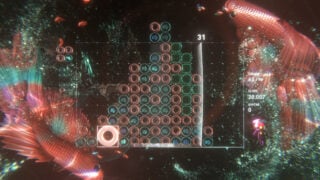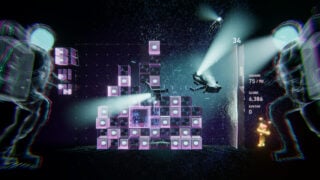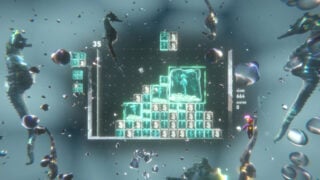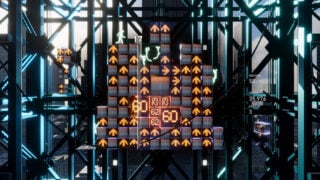Lumines Arise review: Tetris Effect follow-up is an audio-visual delight
Enhance’s high-energy music puzzler sacrifices some substance for supreme style
- Director
- Takashi Ishihara
- Key Credits
- Tetsuya Mizuguchi (Producer)

How do you follow up the ‘Perfect Game’? The answer, probably, is that you can’t. Not on its own terms, anyway. So instead, Lumines Arise, the next music game from Tetsuya Mizuguchi’s Enhance, breaks the rules and does some of the things the phenomenal Tetris Effect couldn’t.
The result is a loud and brash, if somewhat unrefined, synaesthesia puzzler that’s more visually stunning and dynamic than its predecessor, often blurring the lines between gameplay and audio-visual experience in fantastic ways. However, it often does so at the expense of gameplay clarity, and with a soundtrack that, overall, features fewer memorable highs, and far less of the playful tension that made Tetris Effect so brilliant.
Overall, Arise feels like the experimental album, the Kid A to Tetris Effect’s OK Computer. And, ultimately, by following a peerless titan of pop culture with something a bit different, Enhance has created a music puzzle game that complements the game it follows, even if its stacked bricks don’t quite reach as high.
For the uninitiated, Lumines is a Tetris-like game played across a 16×10 grid. A succession of 2×2 blocks made up of two different colors fall from the top of the grid. The aim is to create a 2×2 block of the same color, allowing them to clear.
Unlike the Russian classic, blocks that only partially hit an obstruction will see their remaining parts continue to fall. Another big difference is the ‘Time Line’, a continuous sweeping line that performs the job of clearing the completed squares, forcing players to time their combinations, lest it arrive at the wrong moment and only clear a partial 2×2 block.
Unsurprisingly for a Mizuguchi-produced game, music is an integral part of the Lumines experience, and the tempo of the Time Line and look of the blocks will change along with the game’s soundtrack, which covers a wide spectrum of music genres.
On the surface, there are a lot of throughlines from Effect to Arise. The same director, Takashi Ishihara, and composers, Hydelic, are here, along with an eclectic soundtrack, mesmerizing particle effects, and plenty of uplifting iconography.
Beneath the surface, though, they really are quite different experiences to play. Tetris Effect draws players in with its zen-like gameplay loop, complemented by abstract visuals and an ethereal score.
In comparison, Lumines Arise is a much more chaotic animal, with a booming soundtrack and a psychedelic, ever-changing presentation that refuses to let players settle into a single rhythm. If Tetris Effect is the club terrace, then Lumines Arise is the main room.
For fans of the original Lumines games, with their ultra-chill playlists of Reggae, ambient techno, and titular title theme, Shinin’ by Mondo Grosso, Arise’s forays into thumping trance and dubstep will understandably feel like a departure. But for Arise, this subversion of expectations feels like a smart choice next to Effect, as the high-energy ambience enables Enhance to go much further with some of its ideas, and avoid feeling like a tribute act.
“Lumines Arise is a much more chaotic animal, with a booming soundtrack and a psychedelic, ever-changing presentation that refuses to let players settle into a single rhythm.”
Firstly, the fidelity and dynamism of the visual theming are greatly enhanced, with the game’s 35+ stages frequently swapping abstract presentation for real-world environments like city streets, sandy beaches, and winding train tracks, as well as interactive elements like water ripples or stray cats clambering over your blocks.
Most notably, the blocks themselves are now integrated with the visual design of each stage to an extent far beyond what Tetris Effect attempted. Blocks in Arise now appear as physical objects, such as marbles, flowers, water droplets, or neon signage, and, depending on the theming, will react organically to gameplay, with pieces smashing into the environment, or particles layering on top of other nearby blocks.
It looks stunning and adds a new tangibility to gameplay, with the blocks’ reactivity enhancing the turbulent feel of the overall experience, and they sometimes change midway through a stage, transforming from fruit to vegetables or similar.

However, it’s almost inevitable that with this much dynamism in its visuals, readability can suffer, especially in the most artistically complex stages, like those with realistic pools of water, or giant puppet hands, or eggs that hatch chicks which then jump all over the playfield.
While it never outright spoiled the experience, frequently during my time with Lumines Arise, the visual furniture distracted from the gameplay in some way, either by decreasing the readability of the blocks or by outright obstructing them from view. Arise’s version of Effect’s Zone mechanic, called Burst, also often causes dozens of other player avatars to drop onto the field. Thankfully, many of these elements can be toned down in the settings, but some larger dynamic items cannot.
Many of Arise’s effects, such as pieces of cleared blocks flying towards the screen, feel designed for VR in mind, and it’s here where the game’s artistic direction truly shines. Whereas the visuals can distract from the gameplay during standard TV play, in VR, they enhance immersion in a way not possible with the flat-screen version of the game.
The player is essentially floating in space in front of the gameboard, watching the mammoth fireworks and other visual flourishes fill their vision on each side, with the wider POV providing clearer visibility of the action on screen. The visuals and soundscape of Lumines Arise are ideal for VR, and absolutely justify dusting off the PlayStation VR 2 headset.
Lumines Arise review
Enhance's Tetris Effect follow-up is a loud and brash, if somewhat unrefined, synaesthesia puzzler that’s more visually dynamic than its predecessor, but often at the expense of gameplay clarity.
- Another audio-visual delight from Enhance
- An eclectic Journey mode with fantastic theming
- Plenty of modes and unlockables
- Fantastic in VR
- Chaotic visuals often hamper readability
- Score lacks the playful tension of Tetris Effect
























